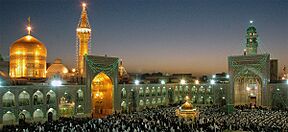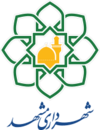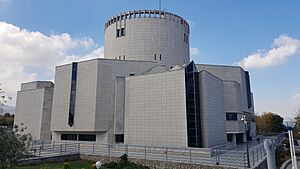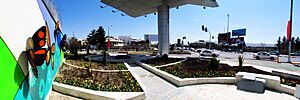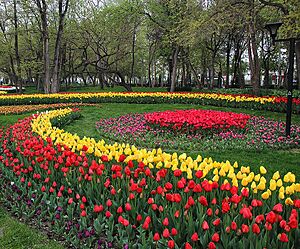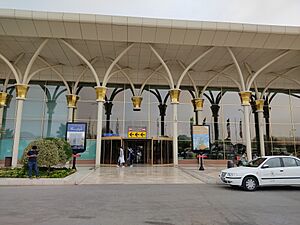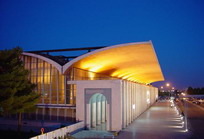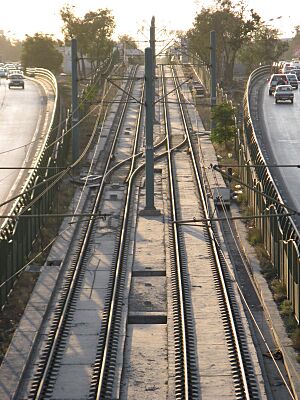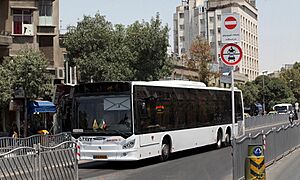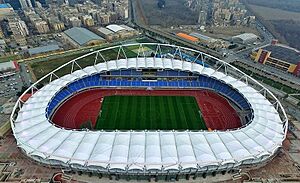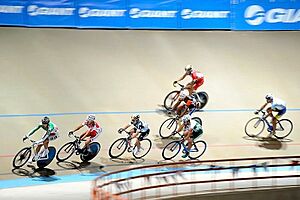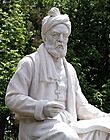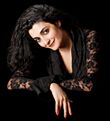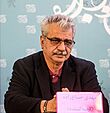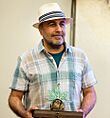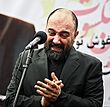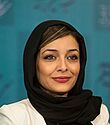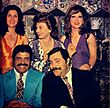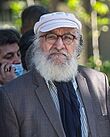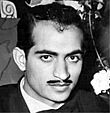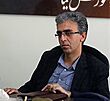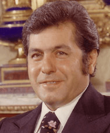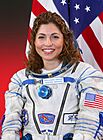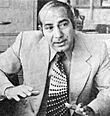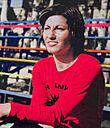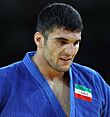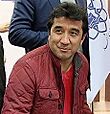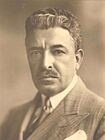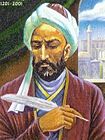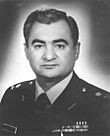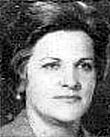Mashhad facts for kids
Quick facts for kids
Mashhad
مشهد (Persian)
Sanaabad, Tus
|
||
|---|---|---|
|
Left to right from top: bird's eye view of Mashhad; Tomb of Ferdowsi; Tomb of Nader Shah; the great museum of Khorasan; Space age memorial monument; Imam Reza Shrine; Imam Hossein square; and Mashhad at night.
|
||
|
||
| Motto(s):
Mashhad: Smart City, City of Hope and Life
|
||
| Country | Iran | |
| Province | Razavi Khorasan | |
| County | Mashhad | |
| District | Central | |
| Mashhad-Sanabad-Tus | 818 AD | |
| Area | ||
| • City | 351 km2 (136 sq mi) | |
| Elevation | 995 m (3,264 ft) | |
| Population
(2020)
|
||
| • City | 2,307,177 | |
| • Density | 6,573/km2 (17,024/sq mi) | |
| • Urban | 3,320,665 | |
| • Metro | 3,416,000 | |
| • Population Rank in Iran | 2nd | |
| Over 25 million pilgrims and tourists per year | ||
| Demonym(s) | Mashhadi, Mashadi, Mashdi (informal) | |
| Time zone | UTC+03:30 (IRST) | |
| Climate | BSk | |
| Largest district by area | District 9 (64 km2, land area) | |
| Largest district by population | District 2 (480,000) | |
| Website | www.mashhad.ir | |
Mashhad (Persian: مشهد) is a very important city in Iran. It's the second largest city in the country by population. You can find it in the northeast, about 900 kilometers from Tehran, the capital. Mashhad is the main city of Razavi Khorasan Province.
Long ago, Mashhad was a small village called Sanabad. It was located on the ancient Silk Road, a famous trade route. The city got its current name, which means "place of martyrdom", because of the Imam Reza shrine. This is where Ali al-Rida, the eighth Shia Imam, is buried. Many people visit this shrine every year, making Mashhad a very holy city.
Famous Persian poet Ferdowsi, who wrote the Shahnameh, was born near Mashhad in a place called Tus. Later, between 1736 and 1796, Mashhad even became the capital of Afsharid Iran under Nader Shah, whose tomb is in the city. Today, Mashhad is still growing and is home to many important artists and writers.
Contents
History of Mashhad
From Ancient Times to Early Settlements
Ancient Greek stories mention that Alexander the Great passed through this area around 330 BC. The land was called "Susia" back then. Some old maps from the Roman era also show a city called Alexandria in this region. Many historians from the 10th to 16th centuries believed that Alexander founded Sanabad, the old name for Mashhad.
Even in old Shia religious texts, there are mentions that Imam Ridha and Harun al-Rashid were buried in a city founded by "the righteous servant, the two-horned one," which is a title often given to Alexander the Great.
The city's older name was Sanabad. It was later renamed Mashhad during the Safavid Empire. The name Mashhad comes from Arabic and means "a place of pilgrimage" or "a place of martyrdom." This name refers to the place where Ali ar-Ridha (Imam Reza), the eighth Imam of Shia Muslims, died. His shrine was built there.
Around the early 800s AD, Sanabad was a small town about 24 kilometers from Tus. It had a summer palace belonging to Humayd ibn Qahtaba, a governor. In 808, the Abbasid caliph Harun al-Rashid died there and was buried under the palace. Later, in 818, Imam Ali al-Ridha was also buried next to Harun's grave.
Mongol Empire and Growth
People began to visit Imam Reza's grave for pilgrimages. By the late 800s, a dome was built over the grave, and many buildings and markets grew around it. The city was destroyed and rebuilt several times over the centuries.
In 1220, when the Mongols invaded, many large cities in the region were destroyed. However, Mashhad was mostly left untouched because of the important graves there. This caused many people who survived the attacks to move to Mashhad, helping it grow. When the traveler Ibn Battuta visited in 1333, he described it as a large town with lots of fruit trees, streams, and mills. He also mentioned a beautiful dome over the mausoleum, decorated with colorful tiles.
A famous dish from Mashhad, "sholeh Mashhadi," is believed to date back to the Mongol invasion. It's a hearty stew made with meat, grains, and many spices.
Timurid and Safavid Eras
Mashhad's importance continued to grow as the nearby city of Tus declined. In 1389, Tus was destroyed by Miran Shah, a son of Timur. Many people who escaped moved to Mashhad, making it the new capital of the area.
Later, under the Timurid ruler Shahrukh Mirza, Mashhad became a major city. In 1418, his wife Goharshad paid for the building of a grand mosque next to the shrine, known as the Goharshad Mosque. This mosque is still standing today and shows how important Mashhad was in the 1400s.
During the Safavid era, Mashhad became even more important for religious reasons. Many religious schools and buildings were built around the Imam Reza shrine. Shah Abbas I even walked from Isfahan to Mashhad to encourage pilgrimages.
Afsharid and Qajar Dynasties
Mashhad reached its peak under Nader Shah, who ruled Iran from 1736 to 1747. He made Mashhad his capital and was a great supporter of the Imam Reza shrine. His tomb is also in the city.
In 1912, the Imam Reza shrine was bombed by Russian artillery. This caused damage to the golden dome and made many people in the Muslim world very upset.
Modern Mashhad
The city began to develop quickly under Reza Shah (1925-1941). New hospitals, factories, and the Mashhad University of Medical Sciences were built. The first power station was installed in 1936, and public transport started in 1939.
After the Anglo-Soviet invasion of Iran in 1941, Mashhad's population grew as people moved from rural areas. The city also got a university in 1949, an airport, and a railway link to Tehran in 1957. Mashhad continued to expand, with its area growing from 16 to 33 square kilometers.
In 1965, a plan was made to improve the area around the Imam Reza shrine. Old buildings were removed to make way for new developments.
Geography and Climate
Mashhad is located at 36.20 degrees North latitude and 59.35 degrees East longitude. It sits in the valley of the Kashafrud River, close to Turkmenistan. The city is surrounded by two mountain ranges, Binalood and Hezar Masjed Mountains.
The mountains help give Mashhad cool winters, pleasant springs, and mild summers. The city is only about 250 kilometers from Ashgabat, the capital of Turkmenistan.
Mashhad has a cold semi-arid climate. This means it has very hot summers and cold winters. It doesn't get much rain, about 250 millimeters per year, and sometimes it snows. Most of the rain falls between December and May. Summers are usually hot and dry, with temperatures sometimes going above 33°C. Winters are cool to cold, with temperatures often dropping below freezing. Mashhad gets a lot of sunshine, over 2900 hours a year.
The highest temperature ever recorded was 43.8°C in July 1998. The lowest was -28°C in February 1972.
| Climate data for Mashhad (1991-2020, extremes 1951-2020) Elevation:999.2 | |||||||||||||
|---|---|---|---|---|---|---|---|---|---|---|---|---|---|
| Month | Jan | Feb | Mar | Apr | May | Jun | Jul | Aug | Sep | Oct | Nov | Dec | Year |
| Record high °C (°F) | 24.0 (75.2) |
27.4 (81.3) |
32.9 (91.2) |
35.4 (95.7) |
40.6 (105.1) |
42.1 (107.8) |
43.8 (110.8) |
42.4 (108.3) |
42.0 (107.6) |
35.9 (96.6) |
31.2 (88.2) |
28.2 (82.8) |
43.8 (110.8) |
| Mean daily maximum °C (°F) | 8.5 (47.3) |
10.6 (51.1) |
15.7 (60.3) |
22.0 (71.6) |
27.9 (82.2) |
33.4 (92.1) |
35.3 (95.5) |
34.0 (93.2) |
29.7 (85.5) |
23.3 (73.9) |
15.6 (60.1) |
10.7 (51.3) |
22.2 (72.0) |
| Daily mean °C (°F) | 2.8 (37.0) |
4.7 (40.5) |
9.5 (49.1) |
15.4 (59.7) |
21.1 (70.0) |
26.4 (79.5) |
28.5 (83.3) |
26.7 (80.1) |
21.9 (71.4) |
15.5 (59.9) |
8.9 (48.0) |
4.6 (40.3) |
15.5 (59.9) |
| Mean daily minimum °C (°F) | −1.8 (28.8) |
−0.1 (31.8) |
4.3 (39.7) |
9.6 (49.3) |
14.3 (57.7) |
18.7 (65.7) |
20.9 (69.6) |
18.8 (65.8) |
14.1 (57.4) |
8.5 (47.3) |
3.6 (38.5) |
0.0 (32.0) |
9.2 (48.6) |
| Record low °C (°F) | −27.0 (−16.6) |
−28.0 (−18.4) |
−13.0 (8.6) |
−7.0 (19.4) |
−1.0 (30.2) |
4.0 (39.2) |
10.0 (50.0) |
5.0 (41.0) |
−1.0 (30.2) |
−8.0 (17.6) |
−16.0 (3.2) |
−25.0 (−13.0) |
−28.0 (−18.4) |
| Average precipitation mm (inches) | 27.5 (1.08) |
35.7 (1.41) |
56.3 (2.22) |
39.4 (1.55) |
30.6 (1.20) |
5.9 (0.23) |
1.7 (0.07) |
0.8 (0.03) |
2.7 (0.11) |
7.9 (0.31) |
17.2 (0.68) |
20.1 (0.79) |
245.8 (9.68) |
| Average precipitation days (≥ 1.0 mm) | 4.8 | 5.7 | 7.4 | 5.5 | 5 | 1.4 | 0.4 | 0.2 | 0.4 | 1.5 | 3.2 | 3.3 | 38.8 |
| Average rainy days | 4.5 | 7.2 | 10.3 | 9.9 | 6.9 | 2 | 0.6 | 0.5 | 0.7 | 2.9 | 5.4 | 5.5 | 56.4 |
| Average snowy days | 5.8 | 2.6 | 0.5 | 0.1 | 0 | 0 | 0 | 0 | 0 | 0.2 | 1.7 | 4.3 | 15.2 |
| Average relative humidity (%) | 70 | 68 | 65 | 57 | 45 | 31 | 28 | 28 | 32 | 43 | 62 | 69 | 50 |
| Average dew point °C (°F) | −3.1 (26.4) |
−1.9 (28.6) |
1.8 (35.2) |
5.4 (41.7) |
6.9 (44.4) |
6.1 (43.0) |
6.7 (44.1) |
4.8 (40.6) |
2.9 (37.2) |
1.4 (34.5) |
0.6 (33.1) |
−1.5 (29.3) |
2.5 (36.5) |
| Mean monthly sunshine hours | 151 | 152 | 173 | 214 | 285 | 347 | 376 | 366 | 312 | 257 | 179 | 151 | 2,963 |
| Source 1: NOAA NCEI(Days with Snowfall 1981-2010) | |||||||||||||
| Source 2: Iran Meteorological Organization(Records) | |||||||||||||
| Climate data for Mashhad (1951–2010) | |||||||||||||
|---|---|---|---|---|---|---|---|---|---|---|---|---|---|
| Month | Jan | Feb | Mar | Apr | May | Jun | Jul | Aug | Sep | Oct | Nov | Dec | Year |
| Record high °C (°F) | 24.0 (75.2) |
26.0 (78.8) |
32.0 (89.6) |
35.4 (95.7) |
40.6 (105.1) |
42.1 (107.8) |
43.8 (110.8) |
42.4 (108.3) |
42.0 (107.6) |
35.8 (96.4) |
29.4 (84.9) |
28.2 (82.8) |
43.8 (110.8) |
| Mean daily maximum °C (°F) | 7.1 (44.8) |
9.3 (48.7) |
14.2 (57.6) |
20.9 (69.6) |
26.8 (80.2) |
32.3 (90.1) |
34.4 (93.9) |
33.1 (91.6) |
28.9 (84.0) |
22.5 (72.5) |
15.5 (59.9) |
9.8 (49.6) |
21.2 (70.2) |
| Daily mean °C (°F) | 1.7 (35.1) |
3.7 (38.7) |
8.5 (47.3) |
14.7 (58.5) |
19.6 (67.3) |
24.4 (75.9) |
26.6 (79.9) |
24.8 (76.6) |
20.3 (68.5) |
14.5 (58.1) |
8.7 (47.7) |
4.0 (39.2) |
14.3 (57.7) |
| Mean daily minimum °C (°F) | −3.8 (25.2) |
−1.8 (28.8) |
2.9 (37.2) |
8.4 (47.1) |
12.4 (54.3) |
16.4 (61.5) |
18.7 (65.7) |
16.5 (61.7) |
11.7 (53.1) |
6.4 (43.5) |
1.9 (35.4) |
−1.7 (28.9) |
7.3 (45.2) |
| Record low °C (°F) | −27.0 (−16.6) |
−28.0 (−18.4) |
−13.0 (8.6) |
−7.0 (19.4) |
−1.0 (30.2) |
4.0 (39.2) |
10.0 (50.0) |
5.0 (41.0) |
−1.0 (30.2) |
−8.0 (17.6) |
−16.0 (3.2) |
−25.0 (−13.0) |
−28.0 (−18.4) |
| Average precipitation mm (inches) | 32.6 (1.28) |
34.5 (1.36) |
55.5 (2.19) |
45.4 (1.79) |
27.2 (1.07) |
4.0 (0.16) |
1.1 (0.04) |
0.7 (0.03) |
2.1 (0.08) |
8.0 (0.31) |
16.1 (0.63) |
24.3 (0.96) |
251.5 (9.90) |
| Average precipitation days (≥ 1.0 mm) | 8.6 | 10.4 | 13.8 | 12.1 | 8.7 | 2.5 | 0.9 | 0.5 | 0.9 | 3.9 | 5.3 | 8.1 | 75.7 |
| Average snowy days | 5.6 | 5.8 | 4.0 | 0.4 | 0.0 | 0.0 | 0.0 | 0.0 | 0.0 | 0.1 | 1.2 | 3.8 | 20.9 |
| Average relative humidity (%) | 75 | 73 | 69 | 62 | 50 | 37 | 34 | 33 | 37 | 49 | 63 | 73 | 54 |
| Mean monthly sunshine hours | 148.3 | 147.5 | 163.3 | 200.4 | 280.4 | 343.2 | 366.9 | 359.7 | 305.2 | 249.5 | 188.3 | 151.6 | 2,904.3 |
| Source: Iran Meteorological Organization (records), (temperatures), (precipitation), (humidity), (days with precipitation),
(sunshine) |
|||||||||||||
People and Culture
Population and Diversity
| Historical population | ||
|---|---|---|
| Year | Pop. | ±% p.a. |
| 1986 | 1,463,508 | — |
| 1991 | 1,559,155 | +1.27% |
| 1996 | 1,887,405 | +3.90% |
| 2006 | 2,427,316 | +2.55% |
| 2011 | 2,766,258 | +2.65% |
| 2016 | 3,001,184 | +1.64% |
| 2022 | 3,619,000 | +3.17% |
| source: | ||
In 2016, Mashhad had a population of over 3 million people. Most people in Mashhad are Persians. There are also groups of Kurdish and Turkmen people who have moved to the city. Some people of Arabian descent also live here and have kept their unique culture.
Every year, more than 20 million pilgrims and tourists visit Mashhad.
| Ethnic Groups | ||||
|---|---|---|---|---|
| Persians | 92.5% | |||
| Kurds | 3% | |||
| Turkmens | 2% | |||
| Arabs | 0.1% | |||
| Others | 0.4% | |||
Religious Importance
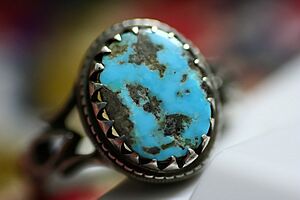
Mashhad is considered the second-largest holy city in the world. It attracts millions of visitors each year, mostly pilgrims coming to honor the Imam Reza shrine. People who complete the pilgrimage to Mashhad are sometimes called Mashtee.
The holy shrine and its museum hold a huge collection of Iranian art and culture. This includes old books and paintings. Many important religious schools are connected to the shrine.
Language and Dialect
The main language spoken in Mashhad is Persian. However, people in Mashhad speak with a special accent called the Mashhadi accent. It's a bit different from standard Persian in how some words are said.
Education and Learning
Mashhad has always been a place for learning, both religious and general. It has been a center for Islamic arts and sciences. There are many Islamic schools, called madrasas, in the city.
The Ferdowsi University of Mashhad is a large university named after the famous Iranian poet. It's known for attracting students from other countries. The Razavi University of Islamic Sciences, founded in 1984, is right in the center of the city, within the shrine complex. These schools attract students who want to study Islamic subjects.
Mashhad is also home to one of the oldest libraries in the Middle East, the Central Library of Astan Quds Razavi. It has a history of over six centuries and holds millions of historical documents. There's also a museum with more than 70,000 rare old books.
The Astan Quds Razavi Central Museum is part of the shrine complex. It displays Islamic art and historical items. A new building for the museum was designed in 1976 by architect Dariush Borbor.
Mashhad also has several art galleries, like Mirak Gallery and Rezvan Gallery.
Cultural Capital
In 2017, the Islamic Educational, Scientific and Cultural Organization named Mashhad the "cultural capital of the Muslim world" in Asia. This led to many international events being held in the city.
Economy and Industries
Mashhad is a major center for making cars in Iran. The city's economy relies on many things, including:
- Dry fruits and nuts
- Saffron
- Iranian sweets like gaz and sohaan
- Precious stones like agates and Turquoise
- Beautiful silver jewelry with rubies and emeralds
- Gold jewelry
- Perfumes
- Religious souvenirs
- Carpets and rugs
Mashhad is famous for its carpets. Some of the oldest carpets from the city date back to the time of Shah Abbas. There's even a special type of carpet called Mashhad Turkbâf, made by weavers who came from Tabriz.
Other important industries in Mashhad include food, clothing, leather, textiles, chemicals, steel, and handicrafts.
Mashhad is a big center for tourism in Iran, with over 55% of all hotels in the country. The religious shrines are the main reason many people visit. Every year, millions of pilgrims and tourists come to Mashhad from Iran and other parts of the world.
Astan Quds Razavi's Role
The Astan Quds Razavi is the organization that manages the Imam Reza Shrine. It's a very powerful group in Mashhad's economy. The land around the shrine has grown a lot since 1979. The foundation owns much of the property in Mashhad, including shops and hotels. Its main income comes from donations and gifts.
Main Sites to See
Besides the Imam Reza shrine, Mashhad has many other interesting places to visit:
- Large parks like Koohsangi park and Mellat Park.
- The tombs of famous historical figures in nearby Tus and Nishapur.
- The tomb of Nader Shah.
- The Koohestan Park-e-Shadi Complex, which has a zoo.
- The Mashhad Airbase, which is also a civilian international airport.
- Khurshid castle, Vakil Abad Park, Miniature Park, Professor Bazima Science Park, Astan Quds Razavi Museum, Keshti Dome, Harunieh Dome, Bird Garden, Anthropology Museum (Mehdi Qolibek Bath), Naderi Museum, and Bread Museum.
Some interesting places are just outside the city:
- The tomb of Khajeh Morad, on the road to Tehran.
- The tomb of Khajeh Rabi', about 6 kilometers north of the city, with writings by the famous calligrapher Reza Abbasi.
- The tomb of Khajeh Abasalt, about 20 kilometers from Mashhad on the road to Neishabur. These three were all followers of Imam Reza.
You can also visit the tomb of the poet Ferdowsi in Tus, about 24 kilometers away. There are also nice summer resorts in places like Torghabeh, Torogh, Akhlamad, Zoshk, and Shandiz.
The Shah Public Bath, built in 1648 during the Safavid era, is a great example of old architecture. It has been restored and will become a museum.
Getting Around Mashhad
Airport Travel
Mashhad has the Mashhad International Airport. It handles flights to other Iranian cities and international flights, mostly to nearby countries. It's the second busiest airport in Iran.
The airport connects to 57 places, with frequent flights to 30 cities in Iran and 27 places in Central Asia, the Middle East, East Asia, and Europe. The airport has been expanded with new terminals and facilities.
Train Travel
The Mashhad railway station has different types of train services: local, regional, and express. The station is owned by IRI Railways. It has daily services from most parts of the country. The building was designed by Heydar Ghiai.
Mashhad is connected to three main rail lines: Tehran-Mashhad, Mashhad-Bafq (going south), and Mashhad-Sarakhs, which is at the border with Turkmenistan. Some cargo trains continue to Uzbekistan and Kazakhstan.
Metro and Light Rail
Mashhad has a metro and light rail system with four lines planned, totaling 84.5 kilometers. Line 1 has been running since 2011 and connects to Mashhad International Airport. It is 24 kilometers long and has 24 stations.
Line 2 is a metro line that is 14.5 kilometers long with 13 stations. The first part of Line 2 opened in 2017. In 2018, the "Shariati" station opened, allowing people to switch between Line 1 and Line 2. Currently, Mashhad has two operational lines with 37.5 kilometers of track and 35 stations. Work has also started on Line 3 and Line 4.
Roads and Buses
Major roads connect Mashhad to other cities. Road 95 goes south to Torbat-e Heydarieh and Birjand. Road 44 goes west towards Shahrud and Tehran. Road 22 goes northwest towards Bojnurd and also to Ashgabat in Turkmenistan.
Mashhad also has a Bus Rapid Transit (BRT) system. These special bus lines help improve traffic and make it easier to get around the city. They offer direct transport to the Imam Reza shrine.
Universities and Colleges
Mashhad is home to many universities and colleges, offering a wide range of studies. Universities
- Ferdowsi University of Mashhad
- Imam Reza International University
- Islamic Azad University of Mashhad
- Khayyam University
- Payame Noor University of Mashhad
- Razavi University of Islamic Sciences
- Sport Sciences Research Institute of Iran
Colleges
- Al Mustafa International University
- Arman Razavi Girls Institute of Higher Education
- Asrar Institute of Higher Education
- Attar Institute of Higher Education
- Bahar Institute of Higher Education
- Binalood Institute of Higher Education
- Cultural Heritage, Hand Crafts, and Tourism Higher Education Center (University of Science and Technology)
- Eqbal Lahoori Institute of Higher Education
- Hakim Toos Institute of Higher Education
- Hekmat Razavi Institute of Higher Education
- Iranian Academic Center for Education, Culture and Research, Mashhad Branch (Jahad Daneshgahi of Mashhad)
- Jahad Keshavarzi Higher Education Center of Khorasan Razavi (Shahid Hashemi Nejad)
- Kavian Institute of Higher Education
- Kharazmi Azad Institute of Higher Education of Khorasan
- Khavaran Institute of Higher Education
- Kheradgarayan Motahar Institute of higher education
- Khorasan Institute of Higher Education
- Khorasan Razavi Judiciary Center (University of Science and Technology)
- Khorasan Razavi Municipalities' Institute of Research, Education, and Consultation of (University of Science and Technology)
- Mashhad Aviation Industry Center (University of Science and Technology)
- Mashhad Aviation Training Center (University of Science and Technology)
- Mashhad Culture and Art Center 1 (University of Science and Technology)
- Mashhad Koran Reciters Society
- Mashhad Prisons Organization Center (University of Science and Technology)
- Mashhad Tax center (University of Science and Technology)
- Navvab Higher Clerical School
- Part Tyre Center (University of Science and Technology)
- Red Crescent Society of Khorasan Razavi (University of Science and Technology)
- Salman Institute of Higher Education
- Samen Teacher Training Center of Mashhad (Farhangian University)
- Samen Training Center of Mashhad (Technical and Vocational University)
- Sanabad Golbahar Institute of Higher Education
- Shahid Beheshti Teacher Training College (Farhangian University)
- Shahid Hashemi Nejad Teacher Training College (Farhangian University)
- Shandiz Institute of Higher Education
- Khorasan Razavi Taavon Center (University of Science and Technology)
- Tabaran Institute of Higher Education
- Toos Institute of Higher Education
- Toos Porcelain Center (University of Science and Technology)
- Khorasan Water and Electricity Industry Center (University of Science and Technology)
- Workers' House; Mashhad Branch (University of Science and Technology)
Sports in Mashhad
Mashhad is home to several sports teams and facilities.
Major Sport Teams
| Club | League | Sport | Venue | Established |
|---|---|---|---|---|
| Abumoslem F.C. |
|
Football | Takhti Stadium |
|
| Shahr Khodro F.C. |
|
Football | Imam Reza Stadium |
|
| Siah Jamegan F.C. |
|
Football | Takhti Stadium |
|
| Samen Mashhad BC |
|
Basketball | Shahid Beheshti Sport Complex |
|
| Mizan Khorasan VC |
|
Volleyball | Shahid Beheshti Sport Complex |
|
| Farsh Ara Mashhad FSC |
|
Futsal | Shahid Beheshti Sport Complex |
|
| Ferdosi Mashhad FSC |
|
Futsal | Shahid Beheshti Sport Complex |
|
| Rahahan Khorasan W.C. |
|
Freestyle wrestling | Mohammad Ali Sahraei Hall |
|
Other Sports Activities
Mashhad hosted the Junior World Championships in sitting volleyball in 2009, where Iran's junior team won gold.
Wrestling is very popular in Mashhad. The traditional Iranian wrestling style, called Pahlevani and zoorkhaneh rituals, is very important here.
Mashhad has a well-equipped cycling track, car racing tracks, motorcycle tracks, and three skating rinks. There are also ski and equestrian tracks. The first golf course in Iran is located in the Samen complex in Mashhad.
Images for kids
-
Imam Reza bus terminus
Mashhad as a Capital City
Mashhad has been the capital city for several rulers and dynasties throughout history:
- Kianid Dynasty
- Malek Mahmoud Sistani (1722–1726)
- Afsharid dynasty
- Nader Shah
- Adil Shah
- Ebrahim Afshar
- Shahrukh Afshar
- Nadir Mirza of Khorasan
- Safavid dynasty
- Soleyman II
- Autonomous Government of Khorasan
- Colonel Mohammad Taghi Khan Pessyan
Famous People from Mashhad and Toos
Artists and Performers
-
Abolghasem Ferdowsi Pazh, famous poet
-
Mohammad-Reza Shajarian, a renowned singer
-
Reza Attaran, an actor
-
Mitra Hajjar, an actress
-
Iran Darroodi, a surreal painter
- 25band, a pop music group formed in 2010.
- Abdi Behravanfar, a singer and guitar player.
- Ali "Dubfire" Shirazinia, a musician and DJ.
- Amir Ghavidel, a film director and script writer.
- Anoushirvan Arjmand, an Iranian actor.
- Borzoo Arjmand, an Iranian actor.
- Dariush Arjmand, an Iranian actor.
- Hamed Behdad, an Iranian actor.
- Hamid Motebassem, an Iranian musician.
- Hosein Eblis, a pioneer of "Persian Rap."
- Homayoun Shajarian, a famous Persian classical music singer.
- Iran Darroudi, an Iranian artist.
- Javad Jalali, an Iranian photographer and cinematographer.
- Mahdi Bemani Naeini, an Iranian film director and photographer.
- Marshall Manesh, an Iranian-American actor.
- Mitra Hajjar, an Iranian actress.
- Mohammad-Reza Shajarian, a highly praised Persian traditional singer.
- Mohsen Namjoo, an Iranian singer-songwriter.
- Navid Negahban, an Iranian-American actor.
- Noureddin Zarrinkelk, a renowned Iranian animator.
- Ovanes Ohanian, an Armenian-Iranian filmmaker.
- Pouran Jinchi, an Iranian-American artist.
- Rafi Pitts, an internationally recognized Iranian film director.
- Reza Attaran, an Iranian actor and director.
- Reza Kianian, an Iranian actor.
- Shahin Ebrahimzadeh-Pezeshki, a textile and costume art historian.
- Hamed Soltani, an Iranian television producer and presenter.
Business Leaders
-
Anousheh Ansari, an Iranian-American engineer and spaceflight participant
- Anousheh Ansari, an Iranian-American co-founder of Prodea Systems, Inc., and a space traveler.
- Hossein Sabet, an Iranian businessman.
- Mahmoud Khayami, an Iranian-born industrialist and philanthropist.
Sports Figures
-
Khodadad Azizi, a football striker
-
Reza Ghoochannejhad, a professional football player
- Abbas Chamanyan, an Iranian football coach.
- Abbas Golmakani, a wrestling champion.
- Abolfazl Safavi, a professional football player.
- Ali Baghbanbashi, an athlete.
- Alireza Vahedi Nikbakht, a professional football player.
- Amir Ghaseminejad, a judoka.
- Amir Reza Khadem, a wrestler.
- Amir Tavakkolian, a wrestler.
- Farbod Farman, a basketball player.
- Farhad Zarif, a volleyball player.
- Ghodrat Bahadori, an Iranian futsal player.
- Hamed Afagh, a basketball player.
- Hamid Reza Mobarez, a swimmer.
- Hasan Kamranifar, an Iranian football referee.
- Heshmat Mohajerani, an Iranian football coach and player.
- Hossein Badamaki, a professional football player.
- Hossein Ghadam, a professional football player.
- Hossein Sokhandan, an Iranian football referee.
- Hossein Tayyebi, an Iranian futsal player.
- Javad Mahjoub, a judoka.
- Khodadad Azizi, a retired professional football striker.
- Kia Zolgharnain, a former futsal player.
- Kourosh Khani, a racing driver.
- Mahdi Javid, an Iranian futsal player.
- Majid Khodaei, a wrestler.
- Maryam Sedarati, an athlete and record holder in high jump.
- Masoud Haji Akhondzadeh, a judoka.
- Mohammad Khadem, a wrestler.
- Mohammad Mansouri, a professional football player.
- Mohsen Ghahramani, an Iranian football referee.
- Mohsen Torki, an Iranian football referee.
- Rasoul Khadem, a wrestler.
- Reza Enayati, a professional football player.
- Reza Ghoochannejhad, a professional football player.
- Rouzbeh Arghavan, a basketball player.
Politicians
-
Abdol-Hoseyn Teymoortash, a statesman
- Abdolhossein Teymourtash, an important Iranian statesman.
- Amirteymour Kalali, an important Iranian statesman.
- Manouchehr Eghbal, a former Prime Minister of Iran.
Scientists and Scholars
-
Nasiroddin (Mohammad) Toosi, a famous scholar
-
Jaber Toosi, a polymath
- Abū al-Wafā' Būzjānī, a Persian mathematician and astronomer.
- Abū Ja'far al-Khāzin, a Persian astronomer and mathematician.
- Jābir ibn Hayyān, a famous polymath, chemist, astronomer, engineer, and physician.
- Nasir al-Din al-Tusi, a Persian scholar and scientist.
- Sharaf al-Dīn al-Ṭūsī, a Persian mathematician and astronomer.
- Mohsen Baqerzada, a publisher.
Writers and Literary Figures
- Abolfazl Beyhaqi, a Persian historian and author.
- Ali Akbar Fayyaz, a historian and literary critic.
- Abu-Mansur Daqiqi, a poet.
- Abusa'id Abolkhayr, a Persian Sufi.
- Anvari, a great Persian poet.
- Asadi Tusi, a Persian poet.
- Ferdowsi, a famous Persian poet.
- Mehdi Akhavan-Sales, a Persian poet.
- Mohammad Mokhtari (writer), an Iranian writer.
- Mohammad-Taghi Bahar, a poet.
Sister Cities
Mashhad has special connections with these cities around the world:
 Karachi, Pakistan
Karachi, Pakistan Karbala, Iraq
Karbala, Iraq Kuala Lumpur, Malaysia
Kuala Lumpur, Malaysia Lahore, Pakistan
Lahore, Pakistan Mazar-i-Sharif, Afghanistan
Mazar-i-Sharif, Afghanistan Najaf, Iraq
Najaf, Iraq Ürümqi, China
Ürümqi, China
Consulates
Mashhad has diplomatic offices from several countries:
Active Consulates
 Kyrgyzstan (since 1996)
Kyrgyzstan (since 1996) Pakistan (since 1975)
Pakistan (since 1975) Turkey (since 2014, also active earlier)
Turkey (since 2014, also active earlier) Turkmenistan (since 1995)
Turkmenistan (since 1995)
Former Consulates
 United Kingdom (1889–1975)
United Kingdom (1889–1975) Russia (1889–1917)
Russia (1889–1917) Soviet Union (1917–1937, 1941–1979)
Soviet Union (1917–1937, 1941–1979) China (1941–?)
China (1941–?) United States (1949–1979)
United States (1949–1979) Poland
Poland India
India Japan
Japan Jordan
Jordan Lebanon
Lebanon West Germany (around 1984)
West Germany (around 1984) Kazakhstan (1995–2009)
Kazakhstan (1995–2009) Saudi Arabia (2004–2016)
Saudi Arabia (2004–2016)
See also
 In Spanish: Mashhad para niños
In Spanish: Mashhad para niños


